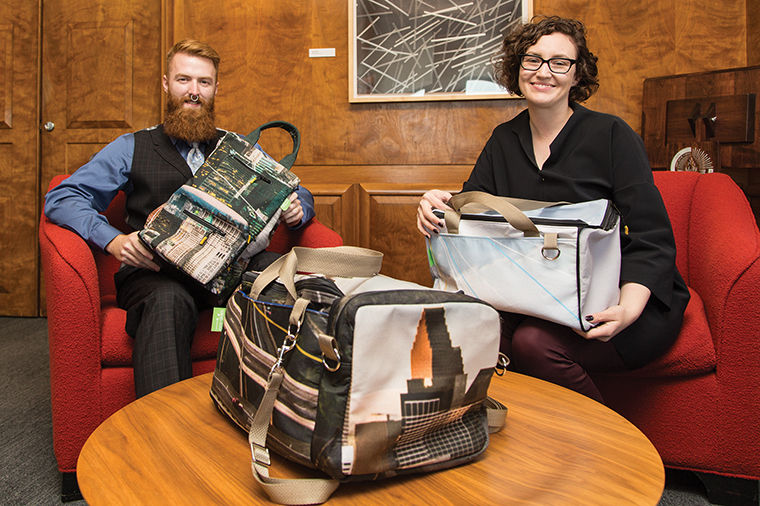Student designs showcased by United Airlines
The designs of Dillon Halford, a freshman fashion studies major, and Anne Tilma, a 2015 fashion studies alumna were chosen to be sold online through the United Airlines shop.
October 19, 2015
A current Columbia student and a recent graduate won a design competition as the culmination of a three-day workshop that required them to promote sustainability for United Airlines.
The airline partnered with assistant professor Beth Shorrock’s “Design for Change” 2015 Spring Semester class in the Fashion Studies Department. Students in the workshop collaborated in resolving challenges and engaging in the creative process while creating social change, Shorrock said.
Students were tasked with designing a carry-on bag made from reusable United Airlines banners that could fit beneath an airplane seat and was economical, yet attractive, durable and fashionable, according to a United Airlines Oct. 15 press release.
Dillon Halford, a freshman fashion studies major, and Anne Tilma, a 2015 fashion studies alumna, were selected as winners by a committee of representatives from the Chicago Department of Aviation, United Airlines and Re:new, a nonprofit Chicago manufacturer that constructed the award-winning bags.
“I am a freshman here at Columbia, so this was a fun challenge,” Halford said. “I love challenges and competition [and] I think that definitely showed.”
President and CEO Kwang-Wu Kim invited Halford, Tilma, Shorrock, Angela Foster-Rice, managing director of Environmental Affairs and Sustainability at United Airlines, and Aaron Stash, senior strategist of Environmental Sustainability at United Airlines, to his office Oct. 13 to congratulate the winners.
“It makes me very proud,” Kim said. “It is such a great example of Columbia College Chicago student innovation and creativity translating into real-world success.”
Kim said the college’s partnership with United Airlines could make other corporate companies aware of the many possibilities that come from connecting with Columbia students.
“It is all about creating positive models, and this is a great example,” Kim said. “It is fun, creative [and] practical. It is generating revenue for a worthy cause, so many pieces of it are valuable.”
Before designing, students toured Chicago’s O’Hare International Airport, where they were taken through security and shown what a traveler experiences when boarding an aircraft to see the amount of personal space a passenger usually has. Next, they met in focus groups with flight attendants to hear what frequent travelers look for in a travel bag. They then had two days to design a prototype and present it to a panel of judges, according to Stash.
Tilma’s award-winning design is an upcycled travel bag that fits the exact dimensions under an airplane seat with a small detachable bag for easy access to valuable possessions while aboard the plane.
Tilma said winning the competition was the best way to end her time at Columbia.
“I have never designed a handbag before, so I enjoyed doing it,” Tilma said. “[I found out product design] may be something I want to pursue that I hadn’t considered.”
Halford’s design is a backpack with easily accessible pockets that can be thrown under an airplane seat. He said he wanted a sophisticated and functional product with maximum selling potential.
Halford added he was immediately interested in the project after finding out it would involve recycling. He said he enjoys creating new things from used materials.
Shorrock added that a challenging aspect of the competition was the limited availability of resources to students.
“The sky wasn’t the limit here,” Shorrock said. “It was a lesson in a lot of aspects of design production.”
The 100 carry-on bags went on sale to the general public online through the United Shop Oct. 16, according to a United Airlines Oct. 15 press release.
All proceeds from the sale of these bags will benefit Re:new and United Airlines’ Eco-Skies Alto Mayo Forest Carbon Project in northern Peru, according to Stash.
Kim said this project was a great example of taking students’ skills and knowledge and stretching them into something different.
“[The students] both said they have never designed something like this before,” Kim said. “They were both thinking of this as product design, but they are realizing the fundamentals are the same and [they] can move in different areas and can succeed.”








